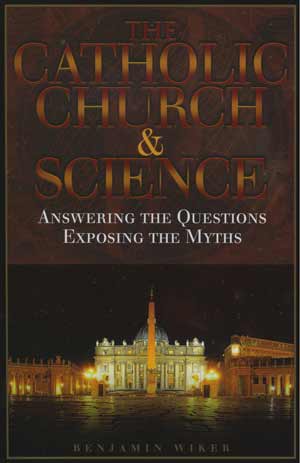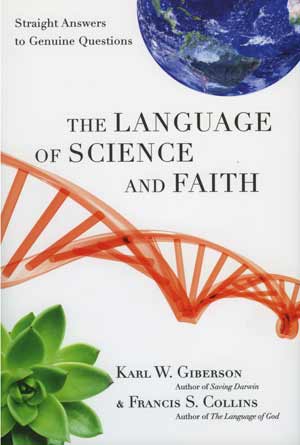 “The Catholic Church and Science: Answering the Questions, Exposing the Myths” by Benjamin Wiker. TAN Books (Charlotte, N.C., 2011). 170 pp., $12.95.
“The Catholic Church and Science: Answering the Questions, Exposing the Myths” by Benjamin Wiker. TAN Books (Charlotte, N.C., 2011). 170 pp., $12.95.
“The Language and Science of Faith: Straight Answers to Genuine Questions” by Karl W. Giberson and Francis S. Collins. IVP Books (Downers Grove, Ill., 2011). 224 pp., $20.
“The Language of Science and Faith” by Karl W. Giberson and Francis S. Collins introduces readers to much of the basics of science, showing how those basics point to a creator God without definitively proving the Father’s existence. Benjamin Wiker’s “The Catholic Church and Science” focuses more on the history of Western science and religion.
Both books oppose the “religion-science conflict” viewpoint. They blame the misconceived science-religion rivalry on atheist philosophers who have used science in their anti-religious fight, thus warping science and turning it into an ideology. Both books argue that, in fact, science and Latin Christianity are intimately linked.
The medieval Christian view held that a reasonable, knowable God had created a reasonable, knowable universe, and that creation was therefore the second book of divine revelation (after the Bible). This gave impetus to scientific exploration of the world. Medieval and early modern churchmen eagerly sought God through scientific knowledge.
The church has been the greatest patron of science, and when squabbles such as that between Galileo and the church happened, they were not religion versus science but inner church and inner scientific squabbles. The church was open to continuously refining its theology to be in accord with the latest scientific findings, but many scientists held strong opinions and used their ecclesiastical power to squash their scientific rivals, much as nowadays scientists skeptical of climate change get silenced.
As Wiker notes, scientific learning thoroughly imbued the church: “In the universities (which were church institutions at the time), even theology was taken up only after the intense study of the seven liberal arts. All theologians were first mathematicians and natural philosophers (scientists).” Theologians, unlike today, were scientifically literate, in other words.
 Wiker observes that the church was the finest instrument the world had theretofore known in the spread of scientific knowledge through its universities: “The universities of Christendom ensured that far more people were mathematically and scientifically literate than in any previous time.”
Wiker observes that the church was the finest instrument the world had theretofore known in the spread of scientific knowledge through its universities: “The universities of Christendom ensured that far more people were mathematically and scientifically literate than in any previous time.”
After setting the background of this most scientific church, Wiker spends much time looking into the Galileo affair, and the slow but certain move toward a heliocentric (sun-centered) view of the cosmos, which Nicolaus Copernicus had taught.
Readers get a strong sense that Copernicus, Galileo and Isaac Newton were resting on the shoulders of giants, including medieval Christian giants such as Albertus Magnus (1193-1280), Thomas Aquinas’ teacher and a scholar of high standing in his own right. He defended the church’s right to explore the physical world, and helped to classify the different branches of medieval science.
In their book, Giberson and Collins spend far more time examining the actual science, showing how absurdly precise the elements need to be to enable life. The core atomic elements must be calibrated just so in order to be able to form planets and stars. Stars need billions of years to “cook” the various elementary compounds, such as carbon, the building block of life. The essential chemistry must itself be incredibly precise if it is to bring life into being. But the authors claim that science has no idea of how chemical compounds suddenly turn into unstable RNA or stable DNA, which form life’s basic components. Life’s origins, and the beginning of the universe itself through the big bang, remain as mysterious as ever.
In addition to all the scientific information, Giberson and Collins ambitiously examine the pros and cons of various theories, such as intelligent design, the biblical fundamentalist view and the standard form of evolution. They accept “Darwinian evolution” because they see no reason why it would prevent a view of God working through this long process to bring about desired change and growth. The most basic atomic elements have total freedom in their movements, which means that nature enjoys the same freedom as humans.
They see no reason why God didn’t work to bring about certain changes throughout the epochs. For example, nature’s solutions to evolutionary problems tend to converge on the same answer. Creatures that share very distant genetic relatives, such as apes and octopus, both developed eyes, even though their shared ancestor had none. Their eyes are remarkably similar. How can scientists explain that?
Wiker focuses more on the social and religious issues, whereas Giberson and Collins incorporate the latest science into their theological musings. Both are challenging though accessible reads for those who want to know more in this exciting field of science, theology and history.
Welter is studying for his doctorate in systematic theology and teaching English in Taiwan.
